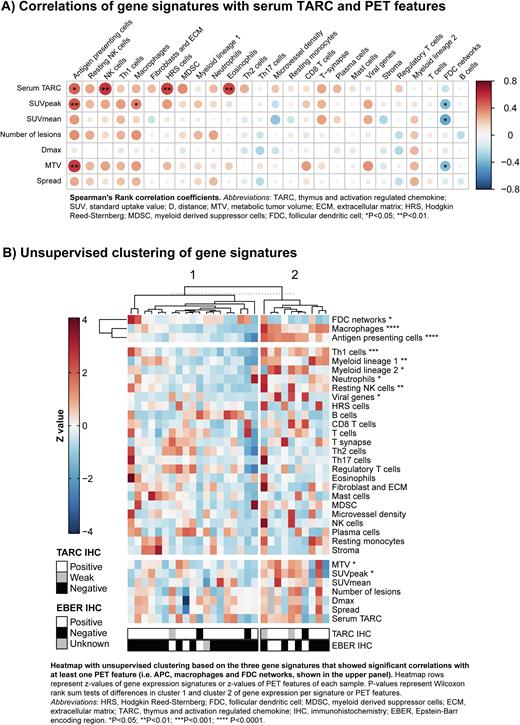Abstract
Background Classical Hodgkin lymphoma (cHL) is a heterogeneous disease characterized by a limited number of Hodgkin Reed-Sternberg (HRS) cells in a complex tumor microenvironment (TME). Presence of cHL can be visualized by 18F-FDG PET-CT and can be detected in serum by measuring the HRS cell-derived chemokine TARC. While both these methods have shown prognostic value, a clear link between HRS/TME composition, serum TARC levels, and glucose metabolism measured by PET is lacking. The aim of this study was to assess correlations between gene expression based cell composition in tissue, quantitative PET features and serum TARC in patients with relapsed or refractory (R/R) cHL.
Methods Lymph node biopsies, PET scans and serum samples at time of relapse were analyzed from 30 patients with R/R cHL who were treated within a clinical trial (NCT02280993). Immunohistochemical (IHC) staining was done for TARC. Soluble serum TARC was measured by ELISA. RNA was extracted from paraffin embedded lymph node biopsies and the expression of 235 genes related to the TME was measured using NanoString probes. The data were normalized on the geometric mean of 10 housekeeping genes. Genes were assigned to various TME signatures according to the literature (Scott et al., JCO 2012). Signature scores were calculated by taking the geometric mean of its constituent genes. PET scans were analyzed using a threshold of standard uptake value (SUV)4.0, which we have validated previously (Driessen et al., JNM 2021). Metabolic tumor volume (MTV), intensity (e.g. SUVpeak, SUVmean) and distance (D) features (e.g. number of lesions, Dmax, the largest distance between two lesions, and spread, the sum of all distances between lesions) were calculated at patient-level. Correlations were assessed using Spearman's rank correlation coefficients. Unsupervised K-means clustering with 1000 repeats was performed on gene signatures that showed a significant correlation with at least one PET feature.
Results As expected, samples with positive TARC IHC staining showed higher TARC (CCL17) expression compared to samples with weak or negative TARC IHC (mean log2 expression 10.2 (95%CI: 9.5-10.8) vs 6.9 (95%CI: 6.2-7.5); p<0.001). The HRS cell signature correlated significantly with serum TARC levels (R=0.54; p=0.002), but not with PET features [Figure 1A]. The NK cell and eosinophil signatures also showed significant correlations with serum TARC levels (R=0.54; p=0.002 and R=0.49; p=0.006, respectively). The macrophage signature correlated significantly with SUVpeak (R=0.39; p=0.039). The antigen presenting cell (APC) signature correlated significantly with serum TARC (R=0.43; p=0.018), SUVpeak (R=0.50; p=0.006) and MTV (R=0.57; p=0.001). Within the APC signature, CD80 and CD40 showed the highest correlations for SUVpeak and MTV. Interestingly, the follicular dendritic cell (FDC) network signature showed significant negative correlations with SUVpeak (R=-0.38; p=0.044), SUVmean (R=-0.43; p=0.019) and MTV (R=-0.37; p=0.046).
Unsupervised clustering based on the three gene signatures that showed significant correlations with at least one PET feature (i.e. APC, macrophage and FDC network) resulted in two distinct clusters with a significant difference in MTV and SUVpeak [Figure 1B]. Cluster 1 was associated with low MTV and SUVpeak, showed significant enrichment for the FDC network signature, and showed a trend for enrichment of B cells (p=0.15) and Th2 cells (p=0.15). Cluster 2 was associated with higher MTV and SUVpeak and showed significant enrichment for APCs, macrophages, Th1 cells, resting NK cells, myeloid lineage 1 and 2, neutrophils and viral genes.
Conclusions We showed significant correlations between several quantitative PET features such as SUVpeak and MTV with gene signatures of macrophages, APCs and FDC networks, but not with the HRS cell signature. This suggests that TME cell types confer a high glucose metabolism which may explain differences in PET features between patients better than the abundance of HRS cells. These findings can aid in the understanding of the biological correlation of PET-CT scan findings in clinical practice and their relationship to cHL pathophysiology.
Disclosures
Tonino:Roche: Honoraria; Incyte: Honoraria; Takeda: Honoraria. Kersten:BMS/Celgene: Consultancy; Kite/Gilead: Consultancy, Honoraria, Research Funding; Miltenyi Biotech: Consultancy, Honoraria; Novartis: Consultancy, Honoraria; Roche: Honoraria; Takeda: Consultancy, Research Funding; Adicet Bio: Consultancy, Honoraria. Diepstra:Takeda: Membership on an entity's Board of Directors or advisory committees, Research Funding.
Author notes
Asterisk with author names denotes non-ASH members.


This feature is available to Subscribers Only
Sign In or Create an Account Close Modal